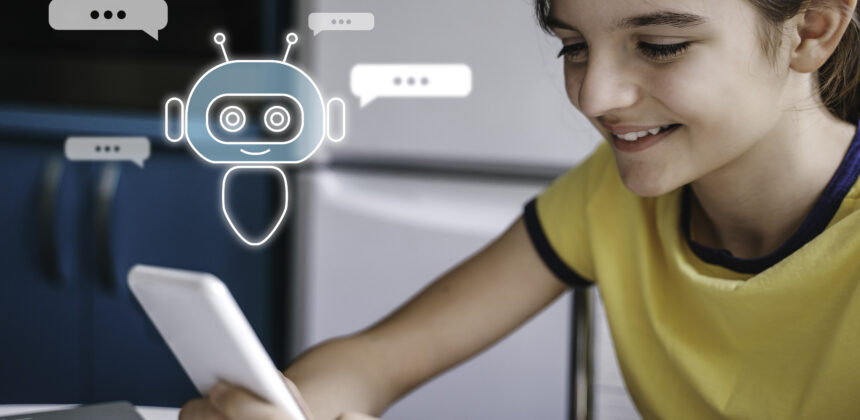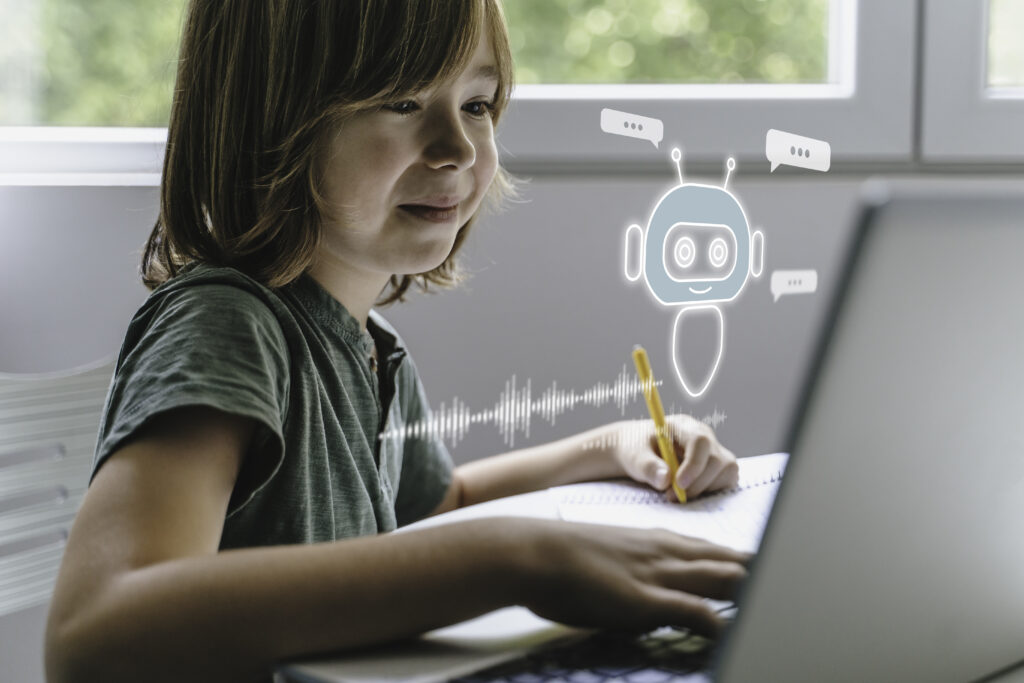Nine Ways to Help Kids Navigate the World of AI

Artificial intelligence (AI) is becoming an increasingly prevalent part of our daily lives, making it important for kids to learn to navigate the world of artificial intelligence. Teaching kids about AI can empower them to make informed media decisions, embrace new technology, and even inspire them to pursue careers in AI-related fields.
Here are nine ways to help kids navigate the world of AI:
How Kids Can Navigate the World of AI
- Explain the basics
- Explore AI entertainment
- Encourage critical thinking
- Talk about ethics and fairness
- Have fun with AI
- Emphasize ethics and bias
- How to be safe in a digital world
- AI in music and art
- Encourage innovation and imagination

1. Start With the Basics: Explain What AI Is
Begin with a simple explanation of artificial intelligence. Use relatable examples like voice assistants (e.g. Siri or Alexa) and autonomous vehicles to help kids understand how AI mimics human intelligence.
Here’s a great way to start the conversation: Artificial intelligence (AI) is like a super-smart friend for computers. It helps them do things that seem clever, just like we do when we learn from our experiences. Imagine Siri or Alexa. Those voice assistants you talk to use AI to understand what you say and give helpful answers. And think about self-driving cars. They’re like cars that can drive themselves without a person steering—they use AI to ‘see’ the road and make safe driving choices.
AI is like a clever problem solver that uses data and patterns. A bit like when you learn new things by practising and paying attention. It’s a tool that makes our lives easier and more interesting!
2. Dive into AI in Entertainment
Talking to your children about AI using entertainment is fun and an excellent way to engage with them.
For example, watch movies like “Wall-E.” Where a robot embarks on an adventure in a post-apocalyptic world. Also, play games like “Minecraft” with AI mods that add new features and challenges. These experiences can heighten their curiosity and open the door to conversations about AI.
While watching Wall-E, you can chat about how a robot can be both intelligent and caring, and in games with AI mods, you can talk about how the game adapts to your actions. This helps kids see how AI can be a creative and fascinating part of storytelling and gaming, making it relatable and inspiring.
3. Encourage Critical Thinking
When it comes to AI, critical thinking skills are essential. It’s important to help kids with the ability to question and analyze AI’s role in society.
Start by having a conversation with your child about AI. Explain how algorithms work and that they are like sets of rules that computers follow to shape their online experiences, such as the recommendations they see on Netflix or YouTube.
Help your kids to consider why they see certain content in their feeds and what influences these suggestions. By having an open discussion around AI-generated content, you can help them understand that AI can be incredibly helpful, although not perfect. It’s crucial to think critically about the information AI provides.
These critical thinking skills will serve them well in navigating the digital landscape with confidence and discernment.
4. Explore AI’s Morals and Fairness
It’s not just about what AI can do, but also about why and how it does it. Engaging in conversations about AI’s ethics and fairness is crucial.
It’s essential to highlight that, sometimes, AI can make unfair choices or reinforce biases present in its training data. Discuss real-world examples where AI systems have shown bias, such as in hiring or facial recognition technology.
By understanding these ethical considerations, kids can develop a sense of responsibility towards AI and its impact on society, fostering a more ethical and equitable future.
5. Have Fun with AI
Learning about AI can be thrilling when it feels like an exciting adventure rather than a daunting task. One fun way is by immersing kids in hands-on AI projects. Platforms like Scratch and TensorFlow can provide a treasure trove of kid-friendly tutorials and activities that transform learning into fun and accessible experiences.
These sites allow kids to create AI-driven games, stories, and even simple chatbots, helping them understand the magic behind AI while sparking their creativity.
By making AI tangible and enjoyable, these projects teach valuable skills and instill a sense of accomplishment and excitement, turning the exploration of artificial intelligence into an unforgettable adventure.
6. Practise Safety in the Digital World
Teaching kids about online safety and privacy is paramount in today’s digitally interconnected world, including when they encounter AI.
It’s important that your children understand how to navigate the world of AI and the digital landscape securely. Begin by discussing the importance of personal information and how AI can sometimes collect and use it.
Teach them the significance of strong, unique passwords and the importance of not sharing them with anyone except trusted adults.
7. Learn With AI: Educational Apps and Websites
With AI-driven educational platforms, kids can explore concepts through fun activities, quizzes, and hands-on projects, providing them with a well-rounded understanding of this fascinating technology.
However, it’s important to speak about the ethics of AI and education. Many AI tools used for writing or doing assignments will likely contain plagiarism, so it’s important to have conversations about AI and homework with your child.
8. AI in Arts and Music
Exploring the intersection of AI in arts and music is an exciting journey in navigating the world of AI.
It’s an opportunity to showcase how AI can fuel creativity, from producing captivating art pieces to composing beautiful music. By digging into AI-generated paintings that merge algorithms with artistic expression or experiencing AI-composed music that stirs emotions, children can witness the magic of AI in the creative process.
Additionally, students can explore AI-powered musical instruments, offering a hands-on experience that ignites their imagination and curiosity, all while navigating the intriguing world of AI in the realms of arts and music.
9. Encourage Innovation and Imagination
Explore AI-made paintings that blend algorithms with art, discover AI-composed music that stirs emotions, and even check out AI-powered musical instruments. By experiencing AI in the arts, kids can see how technology and imagination can work together to create exciting possibilities for the future.
Navigating the World of AI
Navigating the world of artificial intelligence is like embarking on an exciting adventure. We can help our children develop a profound understanding of AI by starting early and embracing a hands-on approach.
With the right guidance and resources, kids can harness the magic of AI to create a brighter and more imaginative future.
Develop Strong Learning Skills at Oxford Learning
AI is not a replacement for underlying fundamental skills: reading, writing, and critical thinking. These skills are required now more than ever. At Oxford Learning, students learn to develop the critical thinking skills that help them think analytically about the world around them. But most importantly, at Oxford Learning, students learn that challenging themselves to learn on their own—without relying on technology—is its own reward.




